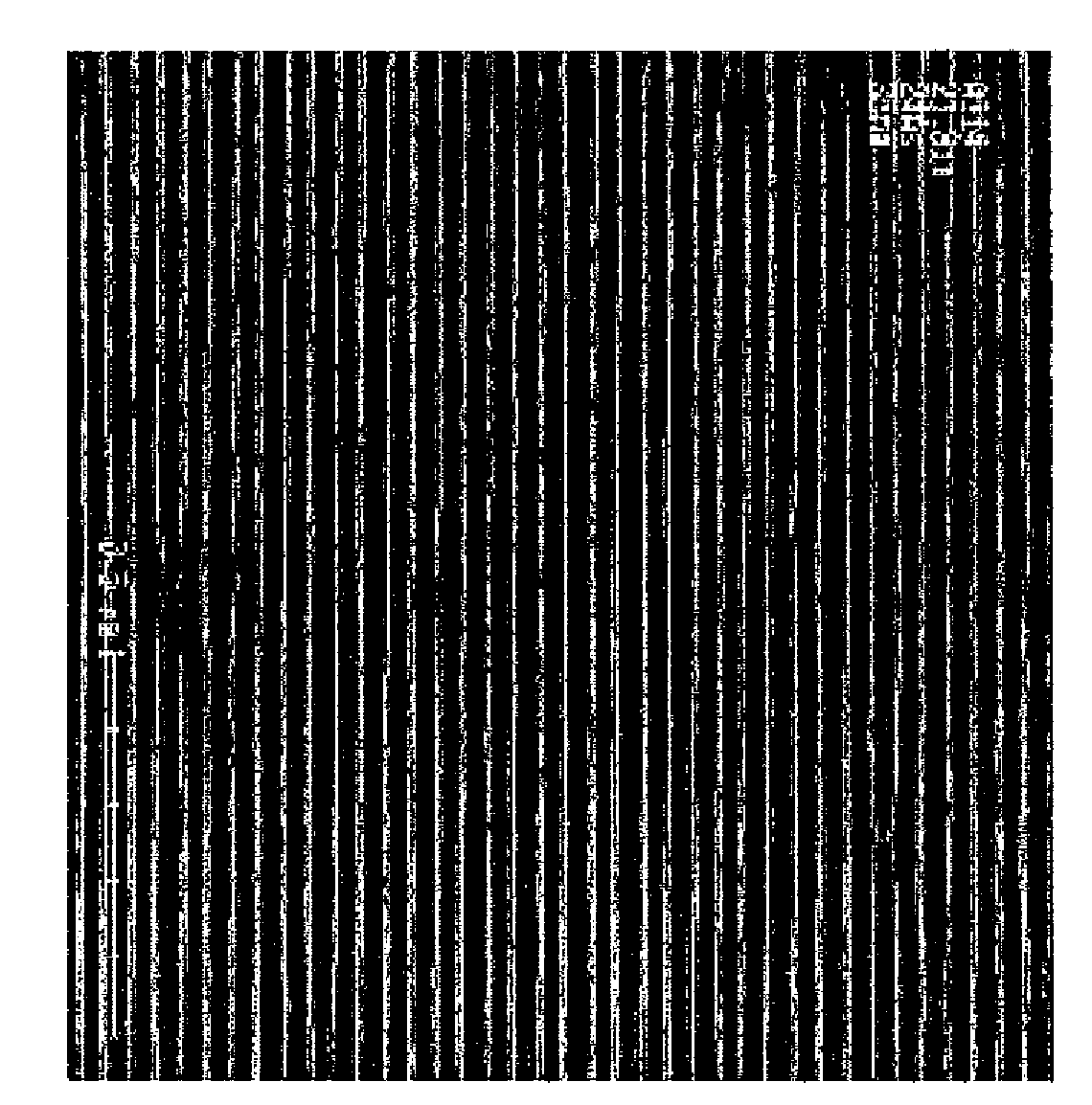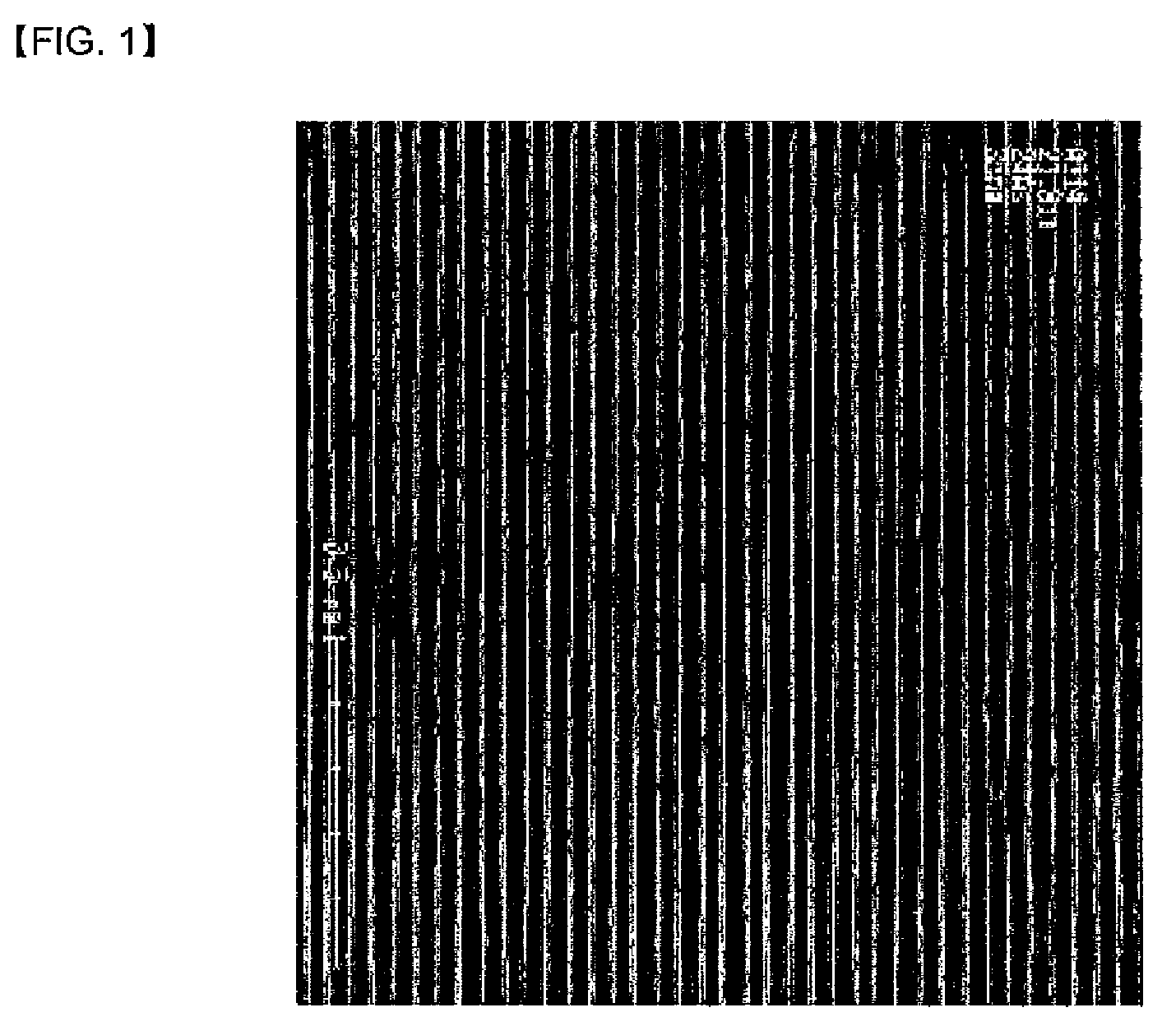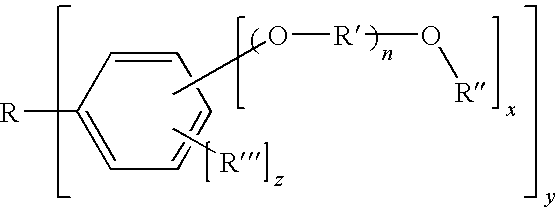Photosensitive compound and photoresist composition including the same
a technology of photoresist and compound, which is applied in the direction of photosensitive materials, instruments, photomechanical equipment, etc., can solve the problems of inability to form patterns with smaller sizes, and resists with polymers as main components that do not offer uniformity for fine patterns, etc., to achieve enhanced photoresist resolution, dry etching resistance, and the effect of improving the minimum resolution of the lithography process
- Summary
- Abstract
- Description
- Claims
- Application Information
AI Technical Summary
Benefits of technology
Problems solved by technology
Method used
Image
Examples
example 1-1
Preparation of Photosensitive Compound Represented by the Formula 2a
[0031]0.01 mol (4.68 g) of methylene-linked para-cresol tetramer and 0.043 mol (4.52 g) of benzyl chloro methyl ether were added into a 250 ml round reaction flask and then 150 ml of toluene was added for dissolving. Thereafter the reflux-reaction was carried out for 6 hours while stirring under the nitrogen atmosphere. The solid component obtained by removing the solvent after completion of the reaction was re-crystallized with 250 ml of tetrahydrofuran(THF) to obtain white-powered compound represented by Formula 2a(Yield: 90%, 1H-NMR: s(7.2, 20H), s(6.8, 4H), s(6.5, 6H), s(6.0, 6H), s(4.6, 6H), s(2.4, 12H)).
example 1-2
Preparation of Photosensitive Compound Represented by the Formula 2b
[0032]0.01 mol (3.06 g) of 1,1,1-tris(4-hydroxyphenyl)ethane and 0.032 mol (3.65 g) of glutaric anhydride were added into a 250 ml round reaction flask and then 150 ml of toluene was added for dissolving. Thereafter the reflux-reaction was carried out for 12 hours while stirring under the nitrogen atmosphere. After the reaction, the solvent was removed and without an additional refining process a white-powered intermediate of compound represented by Formula 2b was obtained(Yield: 70%, 1H-NMR: s(7.09, 12H), t(2.23, 12H), s(2.0, 3H), m(1.8, 6H)).
[0033]0.01 mol (6.5 g) of the intermediate was added to 500 ml 2-neck round flask and then 250 ml of THF solvent was poured and stirred by a magnetic bar for dissolving. Thereafter, under the dry nitrogen atmosphere, 20 wt % THF solution of 0.032 mol (0.93 g) of methoxymethyl chloride was added, and the reaction was carried out for 12 hours at room temperature. After the compl...
example 1-3
Preparation of Photosensitive Compound Represented by the Formula 2c
[0034]0.1 mol (8.4 g) of 3,4-dihydro-2H-pyran and 0.1 mol (13.8 g) of bromoaceticacid were added into a 250 ml round reaction flask and then 150 ml of THF was added to dissolve them. Then 0.6 g of p-toluenesulfonic acid was added as a catalyst while stirring under the nitrogen atmosphere. Thereafter the reflux-reaction was carried out for 12 hours. After the reaction, a liquid intermediate of compound represented by Formula 2c was obtained through a vacuum distillation (Yield: 65%, 1H-NMR: t(6.07, 1H), s(4.26, 2H), t(3.6,2H), t(1.84, 2H), m(1.6, 4H)).
[0035]0.01 mol (2.9 g) of 4,4′,4″-trihydroxytriphenylmethane and 0.032 mol (7.1 g) of the intermediate obtained were added to 250 ml 2-neck round flask and then 80 ml of THF solvent was poured and stirred by a magnetic bar for dissolving. Thereafter, under the dry nitrogen atmosphere, 0.21 g of NaH was added, and the reaction was carried out for 6 hours at room temperat...
PUM
| Property | Measurement | Unit |
|---|---|---|
| Percent by mass | aaaaa | aaaaa |
| Time | aaaaa | aaaaa |
| Weight | aaaaa | aaaaa |
Abstract
Description
Claims
Application Information
 Login to View More
Login to View More - R&D
- Intellectual Property
- Life Sciences
- Materials
- Tech Scout
- Unparalleled Data Quality
- Higher Quality Content
- 60% Fewer Hallucinations
Browse by: Latest US Patents, China's latest patents, Technical Efficacy Thesaurus, Application Domain, Technology Topic, Popular Technical Reports.
© 2025 PatSnap. All rights reserved.Legal|Privacy policy|Modern Slavery Act Transparency Statement|Sitemap|About US| Contact US: help@patsnap.com



